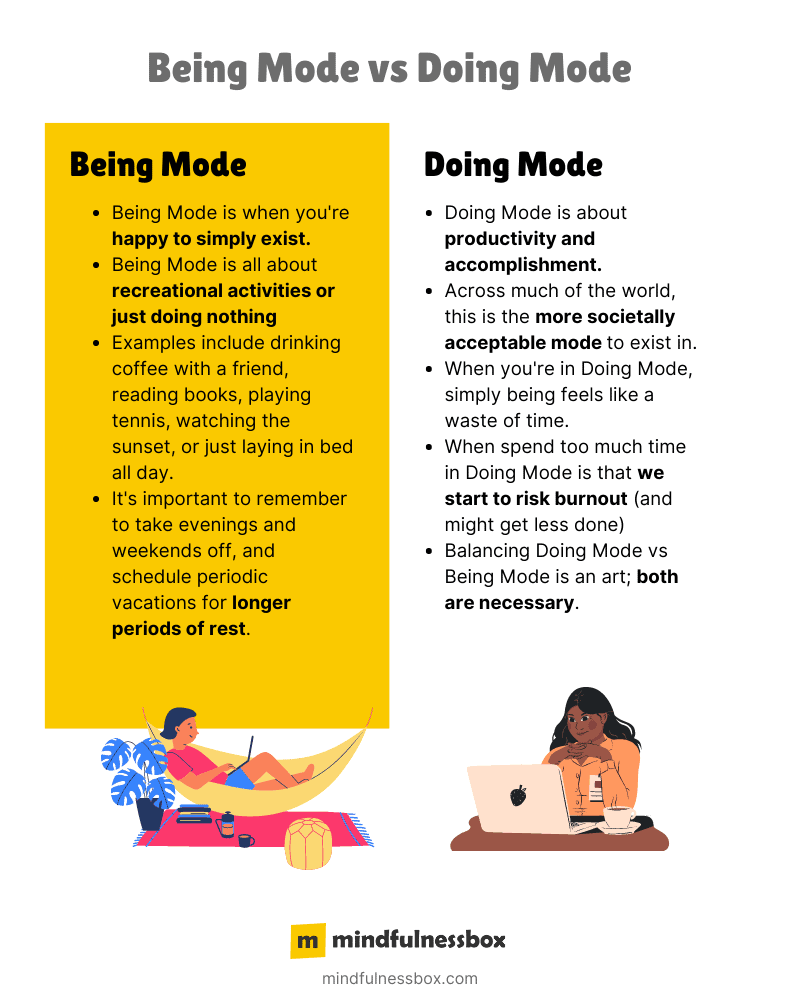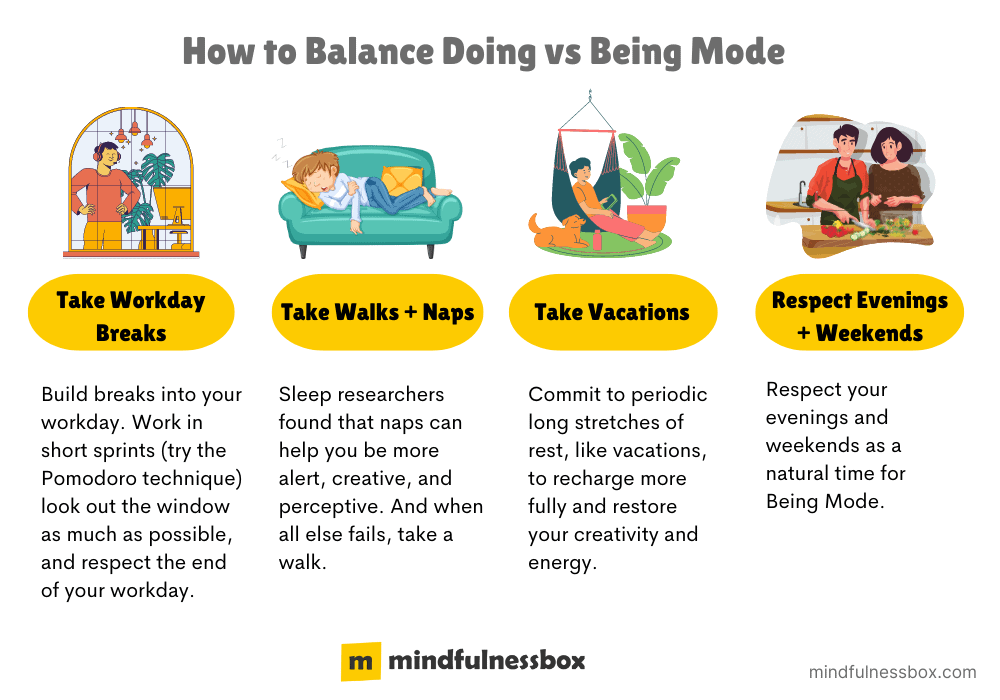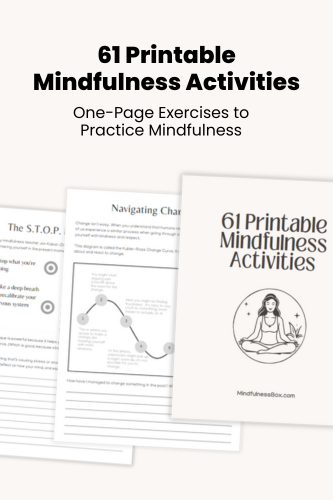Understanding the balance of being vs doing is critical to avoiding burnout and overwork. In Doing Mode, accomplishment and activity are seen as much more valuable than rest. But productivity must be balanced with Being Mode, which prioritizes rest and helps us restore energy and attention for the next burst of activity.
I often fall into the trap of valuing doing higher than being.
I forget to allow myself to simply be, and to enjoy activities that don’t feel productive.
Get dozens of one-page exercises to help practice mindfulness, meditation, gratitude, and self love. Perfect for printable handouts when teaching mindfulness to groups, students, or in the workplace.
To see examples, plus a full list of the 61 exercises included, click below.
It’s easy to forget that resting is its own kind of doing, in a way. Resting helps us restore energy and attention for the next burst of “doing”.
This trap of doing and of overwork is not simply something we fall into on our own. Deprioritizing our rest almost comes to us by default, because of the societal value placed on busy-ness and the omnipresence of work in today’s smartphone and work-from-home era.
Understanding Doing vs Being Mode

Being Mode is when you’re happy to simply exist. Drinking coffee with a friend, reading books, playing tennis, watching the sunset, or just laying in bed all day—these are all fully acceptable in being mode.
Doing Mode is about productivity and accomplishment. Across much of the world, this is the more societally acceptable mode to exist in. When you’re in doing mode, simply being feels like a waste of time.
Striking the right balance between being mode and doing mode is an art.
Some pushing is a good thing. Setting ambitious goals keeps us engaged and generates a sense of mission and a feeling of accomplishment. Testing our limits challenges us, and and helps us do more than we thought was possible
But when we push ourselves too hard, we start to feel like machines.
When Doing Mode becomes counterproductive

We aren’t meant for optimal productivity all the time.
And paradoxically, the more we push ourselves, the less likely we are to get important work done.
You’ve likely seen this play out in your own life. Some examples:
- When you’re trying to meet a deadline and find yourself hitting a wall.
- When you’re low on energy but try and tackle the day normally anyway (but don’t get anything done).
- When your mind is constantly humming but you can’t seem to let yourself relax.
Those are telltale signs you’re pushing yourself too hard.
And unfortunately, it’s actually counterproductive, because if you had used that time to rest instead, you’d be ready to work again sooner.
Avoid burnout by shifting to Being Mode

When you need rest, you’ll notice that you’re working slower than usual, getting distracted more, getting less done, and sinking into a state of low motivation.
When you head off for that third coffee, you probably need rest – not coffee.
The problem is, we often misread these signals as a lack of commitment. No pain, no gain – right?
Rather than acknowledging that our motivation is taking a dive and that our bodies are asking for rest, we feel like we can push through the wall to the other side.
But pushing ourselves too hard for too long leads to burnout. And the only antidote to burnout is rest.
To avoid burnout, we need a mixture of short bursts of rest (like evenings and weekends) and long stretches of rest (like vacations). Rest restores our energy and refuels our creativity.
Of course, rest takes time, but paradoxically, it actually makes us more productive in the long run. Rest allows us to recharge and be more productive when we return to work. Resting also helps keep our focus and attention at optimal levels.
In fact, test across numerous companies have shown that a four-day week is as productive, or more productive, than a five-day week, and leads to greater satisfaction and work-life balance.
Basecamp, a software company, found that “Three-day weekends mean people come back extra refreshed on Monday. Three-day weekends mean people come back happier on Monday. Three-day weekends mean people actually work harder and more efficiently during the four-day work week.”
The importance of rest and relaxation

Rest helps you get more done, but the benefits don’t stop there.
Going on vacation can help you feel more energetic, happier, less tense and more satisfied with your life, according to Scientific American magazine.
When we rest, we’re more creative. When we’re rested, we’re more focused and motivated, and we’re able to come up with new ideas more easily.
And of course, a wide array of health benefits are attributed to getting proper rest, including reduced stress and anxiety, improved mood, decreased blood pressure, and improved immune health.
Showing up to work with reduced stress, more creative and in a better mood can more than make up for the time used by rest.
Work like a lion

Some days, you find yourself with inspiration, and some days, you don’t.
That’s the genesis of the idea of “working like a lion.”
Here’s what Naval Ravikant had to say about it:
“We’d like to view the world as linear, which is, I’m gonna put in eight hours of work, I’m gonna get back eight hours of output, right? Doesn’t work that way. Guy running the corner grocery store is working just as hard or harder than you and me. How much output is he getting?…Outputs are non-linear based on the quality of the work that you put in. The right way to work is like a lion.”
Lions wait for the right moment to hunt; then they hunt; and then they get back to resting. And they rest for between 16 and 20 hours a day.
In the context of modern work, that might mean choosing to work only on the things that make the most impact, and then allowing yourself to work on those things when you feel most inspired and motivated.
We don’t all have the flexibility to adopt a schedule like this, but for those that do, it may be worth a try. At the very least, it’s worth giving yourself permission to push at those moments you feel inspired, and ease off at those moments where everything feels harder.
How to balance Doing versus Being Mode

In addition to the obvious steps like limiting the hours you work and making sure you take a break for lunch, there are a number of techniques that can help create windows of rest within the workday.
Here are some techniques to balance being mode and doing mode by incorporating windows of rest.
- Use the Pomodoro technique: The Pomodoro technique is based on the idea of working in 25-minute intervals with 5 minute breaks in between each interval. Working in short bursts like this guarantees small breaks throughout your day.
- Look out the window: Following the so-called 20/20/20 rule, you can make an effort to look out the window for 20 seconds at something 20 feet away every 20 minutes (this is easily combined with the Pomodoro technique)
- Taking naps: Sleep researchers have found that daytime naps can help you be more alert, creative, perceptive and have a lower chance of stress and heart attacks.
- Respect the end of your workday: Rather than letting your workday bleed into your rest time, protect your rest time by setting a time for the end of your day (rather than stopping when it feels like your tasks are complete)
- Take a walk: When all else fails, take a walk. Walks are a quick way to get your body moving and shift your mind into a different context.
In addition, it’s important to respect your evenings and weekends as a natural time for being mode, and to commit to periodic long stretches of rest, like vacations.
Your body will tell you when it needs to rest

Your body will tell you when it needs rest.
Pay attention to any feelings of distraction, frustration, tiredness, slowness or a general sense that you’re “hitting a wall” and can’t get much done.
Rather than push through these feelings, consider if this is your body telling you something, and decide if it’s time to take action.
Would you be better served by taking a break over lunch to walk around the block, rather than pushing through that task? Are you running on fumes because it’s been months since you had a break of more than two days?
Listen to your body, and make a plan of action that respects the fact that rest is a tool rather than an inconvenience. You may find that you need to bargain with yourself: for example, “I’ll stop work early today, but I’ll start again a little early tomorrow when I’m refreshed.” If so, that’s okay.
When all else fails, take a walk or have a nap.
Who knows: you might even get more done.
Further reading
For more on mindfulness and productivity, check out the articles below:
- 11 Flow Triggers to Induce Flow State
- Monotasking: How to Stop Multitasking and Work Mindfully
- How to Improve Focus with Mindfulness and Flow

My mindfulness practice kicked off in 2016 with a ten-day silent retreat. Since then, I’ve read dozens of books about mindfulness and completed hundreds of hours of meditation. Thinking about what makes humans happy, calm, and peaceful is endlessly fascinating to me.


